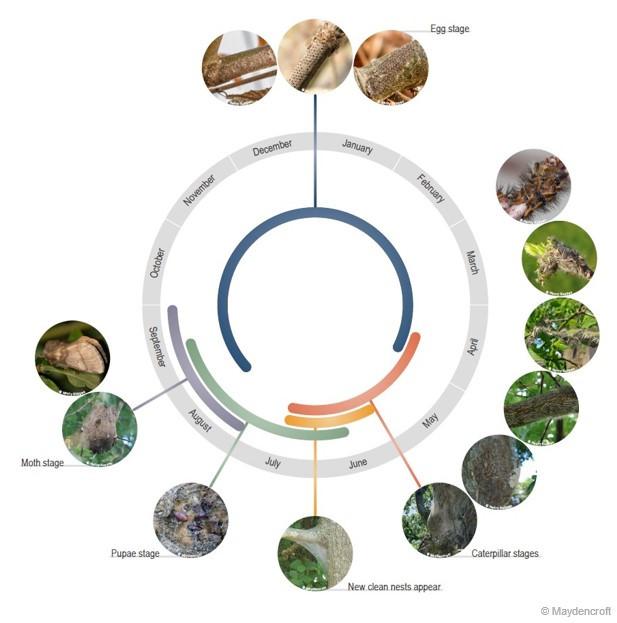Life Cycle
The stages of life the Oak Processionary Moth goes through

-
Egg stage
Egg stage
- Eggs are laid in masses or plaques about 2cm long on high branches and twigs
- Females can lay between 100-300 eggs each year
- Egg plaques are covered with greyish scales and remain on trees during the following autumn and winter.
- First stage larvae hatch from eggs in April
- Moths will lay eggs on multiple oak trees
-
Instar L1 - Mid April
Instar L1 - Mid April
- Eggs will hatch just prior to bud burst;
- Caterpillars are <3mm with black heads and orange bodies;
- They feed at night and stay in the leaf buds.
-
Instar L2 - Early May
Instar L2 - Early May
- Caterpillars shed skin as food and temperature increases;
- The caterpillars remain in the extremities of branches.
-
Instar L3 - Mid May
Instar L3 - Mid May
- Caterpillars are now between 10-15mm long;
- They aggregate in large groups and have started to produce toxic hairs.
-
Instar L4 - End of May to Mid June
Instar L4 - End of May to Mid June
- Roughly 20-25mm;
- They start to form tents, clean and pale in colour;
- There is an accumulation of shed skin and have approximately 700,000 toxic hairs each.
-
Instar L5 - June to Mid July
Instar L5 - June to Mid July
- Caterpillars are now much easier to identify at roughly 30mm;
- Nests are larger and covered in silk and shed skins;
- There are clear signs of feeding damage.
-
Instar L6 - Late June to Late July
Instar L6 - Late June to Late July
- Caterpillars are roughly 35mm in size;
- Large, dirty nests brown in colour from shed skins, located on trunk and scaffold limbs.
-
Pupae
Pupae
- At ground level with grass incorporated;
- Contains a lot of excrement and shed skins;
- Remains hazardous for many years due to hairs.
-
Adult Moth
Adult Moth
- Moths start emerging around Mid July and all will have emerged by late September;
- Moths are nocturnal and live for only three to four days and do not feed;
- Males emerge before females and can fly up to 20km (12 miles);
- Females are seldom found more than 500m from their ‘home tree’ and are attracted to the ‘scent’ of oak;
- Adult moths are not easily distinguishable from some other species.
-
-
-
-
UVDB Achilles
UVDB Achilles
-
ARB Approved Contractor
ARB Approved Contractor
-
Safecontractor
Safecontractor
-
BASIS Amenity Assured
BASIS Amenity Assured
-
Constructionline
Constructionline
-
The Contractors Health and Safety Assessment Scheme
The Contractors Health and Safety Assessment Scheme
-
Property Care Association (PCA)
Property Care Association (PCA)
-
-
The Amenity Standard
The Amenity Standard
-
Forestry Industry Safety Accord (FISA)
Forestry Industry Safety Accord (FISA)
-
Royal Forestry Society
Royal Forestry Society
-

